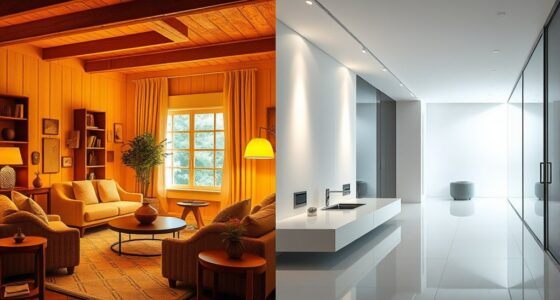Japandi style blends Japanese minimalism with Scandinavian coziness, focusing on simplicity, clean lines, and uncluttered spaces. It emphasizes natural materials like wood, linen, and stone to create a sense of calm and authenticity. You’ll find furniture that’s functional yet streamlined, with soft neutral colors and warm lighting that adds serenity. Every element serves a purpose to maintain balance and harmony. If you want to explore how to incorporate these principles into your space, there’s more to discover below.
Key Takeaways
- Combines Japanese minimalism with Scandinavian coziness for a calm, balanced environment.
- Uses neutral color palettes and natural materials like wood, linen, and stone.
- Features simple, functional furniture with clean lines and low profiles.
- Emphasizes soft lighting, handcrafted accessories, and uncluttered spaces.
- Prioritizes simplicity, craftsmanship, and natural textures to create an inviting atmosphere.

Have you ever wondered how to combine the minimalist elegance of Japanese design with the cozy warmth of Scandinavian decor? The secret lies in embracing Japandi style, which seamlessly blends these two aesthetic worlds into one harmonious look. At its core, Japandi champions minimalist aesthetics, emphasizing simplicity, clean lines, and uncluttered spaces. You’ll want to focus on creating an environment that feels calm and balanced, avoiding excess and emphasizing intentional design choices. The key is to let natural materials take center stage, as they add texture, warmth, and authenticity to the space. Think about using wood with visible grain, soft linens, and stone accents that evoke a sense of nature and tranquility.
When you’re curating a Japandi space, start with a neutral color palette. Soft beiges, warm greys, and muted earth tones set a peaceful foundation. These colors work perfectly with the natural materials you’ll incorporate, creating a cohesive look that’s both modern and inviting. Keep furniture streamlined and functional, avoiding ornate details. Opt for low-profile pieces with smooth surfaces that highlight craftsmanship without cluttering the visual field. This approach allows the natural beauty of the materials to shine through, reinforcing the minimalist aesthetic. Incorporating natural elements like plants and textured materials can enhance the organic feel.
Lighting plays an essential role in achieving Japandi style. Use soft, ambient light sources that mimic natural daylight, such as paper lanterns or simple pendant fixtures. These lighting choices enhance the warmth of natural materials and add a touch of serenity to your space. Remember, less is more; avoid overwhelming the room with excessive accessories. Instead, select a few well-chosen decorative items, like a handcrafted vase or a woven basket, that complement the natural materials and reinforce the minimalist aesthetic.
Incorporating natural elements into your decor doesn’t mean just choosing earthy colors and materials. It also involves thinking about the textures and tactile qualities of your furnishings. For example, a linen throw or a wooden tray can add subtle layers of comfort and visual interest without disrupting the clean lines. The idea is to create a space that feels effortless yet thoughtfully curated, where every piece serves a purpose and contributes to the overall harmony.
Achieving a true Japandi style is about balance—melding the simplicity and functionality of Scandinavian design with the refined elegance and natural focus of Japanese aesthetics. By emphasizing minimalist aesthetics and prioritizing natural materials, you craft a space that’s both calming and stylish. It’s a look that invites you to slow down, appreciate the beauty of simplicity, and find comfort in the natural world around you.
Frequently Asked Questions
How Does Japandi Style Incorporate Sustainability?
Japandi style emphasizes sustainability by prioritizing eco-friendly practices and sustainable materials. You can incorporate reclaimed wood, bamboo, and other renewable resources to create a minimalist, functional space. Using natural, low-impact finishes and avoiding excess waste reflects its eco-conscious ethos. This style encourages you to choose durable, timeless pieces that last, reducing environmental impact and supporting a more sustainable lifestyle.
Can Japandi Design Suit Small Spaces Effectively?
Yes, Japandi design suits small spaces effectively. You can optimize your space by choosing furniture with clean lines and multi-functional pieces, which maximize utility without cluttering. Focus on minimalist aesthetics, using neutral tones and natural materials to make the area feel open and calming. Thoughtful furniture selection helps create a balanced, serene environment, making your small space both functional and stylish, aligned with Japandi principles.
What Are Common Color Palettes in Japandi Interiors?
You’ll find that the common color palettes in Japandi interiors revolve around neutral tones and muted hues, creating a calming and sophisticated atmosphere. Think soft beiges, gentle greys, and warm browns, accented with subtle blacks or deep blues for contrast. These colors subtly blend functionality with serenity, inviting you to relax. The secret lies in how these muted shades interact, transforming your space into a tranquil sanctuary you’ll never want to leave.
How Do I Blend Japandi With Other Decor Styles?
To blend Japandi with other decor styles, you should focus on mixing textures and combining patterns carefully. Start by incorporating natural materials like wood and linen, then add accents with different patterns to create visual interest. Keep a balanced color palette to maintain harmony. You can also introduce modern or rustic elements, ensuring they complement Japandi’s minimalist elegance without overwhelming its calm, serene vibe.
What Are Essential Furniture Pieces for Japandi Decor?
You need essential furniture pieces that embody simplicity, functionality, and elegance. Opt for minimalist lighting that offers clean lines and soft illumination, creating a calming ambiance. Incorporate natural textiles like linen or cotton for upholstery and curtains, adding warmth and texture. Select low-profile, sleek furniture such as a wooden sofa, a simple coffee table, and open shelving. These pieces blend form and function, perfectly capturing the essence of Japandi style.
Conclusion
In embracing Japandi style, you’ll find harmony, health, and happiness at home. By blending balance with beauty, simplicity with sophistication, you create a space that’s both serene and stunning. Remember, minimalism isn’t just about less; it’s about more meaning and mindfulness. So, start your stylish journey today—savor the serenity, embrace the elegance, and let your space speak softly yet profoundly, showcasing your unique style with effortless ease.









